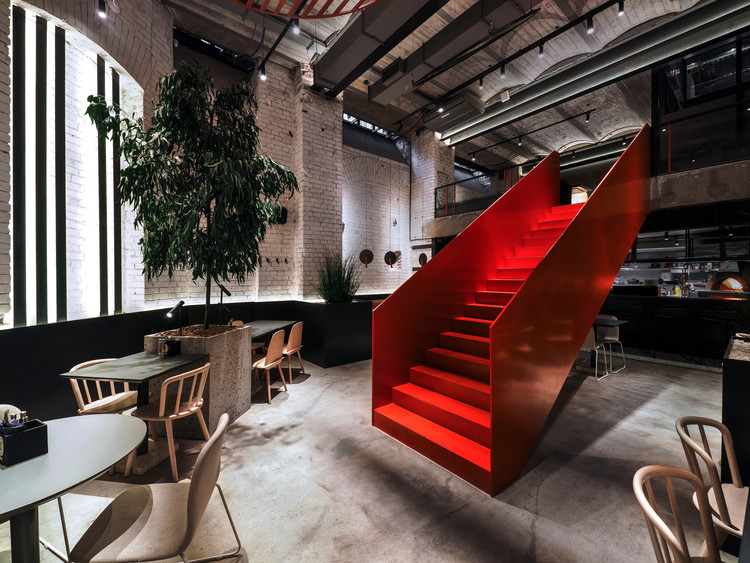PUUUR Blok Atelier PUUUR
2017-02-06 15:00
架构师提供的文本描述。胡塞文(木材码头)地区是在1876年挖掘的木材转运和储存,变得过时,插入港口是在1945年。
Text description provided by the architects. The Houthaven [wood docklands] area was dug in 1876 for the transshipment and storage of wood, becoming obsolete, the insertion ports were filled in 1945.
在未来的几年里,这些旧的港口将被再次挖掘,该地区将被改造成一个带有运河的豪华住宅区。
Within the coming years these old ports will be excavated again and the area will be transformed into a luxurious residential area with canals.
PUUUR Blok公寓是住房地带“Blok 0”的一部分,由10块相连的地块组成,确保了在经济危机期间,经过长时间的停滞后,Houthaven项目的位置重新启动。布鲁布洛克是第一个完成新建住房建设计划的2.500栋新房。
The apartment PUUUR BLOK is part of the housing strip ‘Blok 0’, consisting of 10 contiguous plots, ensured that after a long period of stagnation the Houthaven project location was reactivated during the economic crisis. PUUUR BLOK is the first completed new housing construction of the planned 2.500 new houses.
PUUUR Blok在2015年获得了著名奖项Zuiderkerkprijs的一等奖,这是阿姆斯特丹市政府颁发的阿姆斯特丹最佳新建住房项目年度奖,并由专业评审团颁发。2016年,PUUUR Blok也被提名为每年一度的阿姆斯特丹建筑奖Gouden A.P.。
PUUUR BLOK won the first prize of the prestigious award Zuiderkerkprijs in 2015, this is an annually prize for the best new build housing project in Amsterdam, awarded by the municipality of Amsterdam and a professional jury. In 2016 PUUUR BLOK was also nominated for the annually Gouden A.A.P. , Amsterdam Architecture Prize.
PUUUR Blok由一层9层的高层和18套公寓组成,低层部分有两个码头房屋,中间有一个庭院。所有这些都是在一个2层的地下停车场和储藏室的顶部,在一个高度的城市密度。
PUUUR BLOK consists of a highrise section of nine layers with 18 apartments and a low rise section with two quay houses with a courtyard in between. All this on top of a 2-layer underground car park and storerooms, in a highly urban density.
所有的房子都有明亮的房间,大露台从20平方米到60平方米不等。
All houses feature bright rooms with big terraces ranging from 20m2 to 60m2.
豪华的大型阳极化铝折叠窗使得这些装饰件具有相邻内部的延伸部。坚固、开放的立面与Dockland的工业特性相匹配,提供全景视图。
The luxurieuos large anodized aluminum folding windows makes these terasses an extension of the adjacent interiors. The sturdy, open facade matches the industrial character of the dockland, offering a panoramic view.
石灰华石墙在每个楼层上交替地鸣响和凿毛,以精细的细节与阳光,使建筑呈现出不同的外观。有一个健身房和屋顶露台,在30米高的社区使用。公寓业主协会是建筑物内的零售空间的所有者,其次是主入口。这个咖啡馆提供了这个新领域的当地商店的需要。
The Travertine stone facades are honed and chiseled finished, alternately on each floor, for a subtle detail with sunlight, giving the building a different appearance seen up close. There is a gym and roof terrace at 30m height for communal use. The apartment owners association is owner of the retail space in the building, next to the main entrance. This cafe provides in the need for local shops in this new area.
这座建筑是一个由不同大小和形状的住宅单元(如俄罗斯方块游戏)组成的框架,所有定制公寓的数量和类型都完全由20名客户的需求决定,而不是事先确定的。即使在开发的最后阶段,框架和安装系统的设计方式也使更改和灵活性成为可能。
The building is a framework built up with residential units of different sizes and shapes like the Tetris game, the amount and typologies of all the custom designed apartments are completely established by the needs of the 20 clients and were not determined in advance. The framework and installation systems have been designed in a way that changes and flexibility was made possible even in the end stage of the development.
该建筑具有独特的可持续能源系统,地板采暖连接到城市供暖和城市冷却系统。工业余热在北宁冬季回用取暖,夏季IJ运河的冷水用于地板的冷却。
The building has a unique sustainable energy system, the floor heating is connected to a Cityheating and Citycooling system. Residual heat from the industry is beiing re-used in the winter for heating and in the summer the cool water from the IJ Canal is beiing used for cooling the floors.
太阳能电池板,额外的绝缘外墙,三层玻璃,和公共热回收通风系统,确保该建筑产生能源,并有一个较低的能源需求。
Solar panels, extra insulated facades, triple layered glazing, and a communal heat recovery ventilation system ensures this building generates energy and has a low energy requirement.
停车位有单独的充电设施。混凝土结构的设计是为了将来的新公寓布局和分区是相对容易实现的。
The parking spaces have individual electric charging facilities. The concrete structure is designed in a way that for the future new apartment layouts and divisions are relatively easy to be realized.
西北面的阳台受益于下午的阳光。滑动玻璃板系统降低了这一边邻近行业的理论噪音,如果窗户能够打开,这是城市强加的要求。此外,这第二种皮肤,使它有可能在冬季使用阳台。
The northwest facade features balconies benefitting the nice afternoon sun. The sliding glass panel system reduces the theoretical noise from the adjacent industry at this side, a requirement imposed by the city if windows were able to be opened. In addition this second skin, makes it possible to use the balconies during the winter.
 举报
举报
别默默的看了,快登录帮我评论一下吧!:)
注册
登录
更多评论
相关文章
-

描边风设计中,最容易犯的8种问题分析
2018年走过了四分之一,LOGO设计趋势也清晰了LOGO设计
-

描边风设计中,最容易犯的8种问题分析
2018年走过了四分之一,LOGO设计趋势也清晰了LOGO设计
-

描边风设计中,最容易犯的8种问题分析
2018年走过了四分之一,LOGO设计趋势也清晰了LOGO设计













































































































































